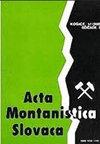Electromechanical wave systems for mineral extraction
IF 1.4
4区 地球科学
Q2 GEOSCIENCES, MULTIDISCIPLINARY
引用次数: 1
Abstract
The problems of the development of mineral deposits related to the technologies of extraction, transportation and processing of viscous, gaseous and bulk materials, including in mixed fractions, are analysed. To solve the problem of efficient transport technologies, a combination of electromagnetic effects with a bionic approach based on the use of the principles of motion dynamics of dolphins, fish and amphibians with a wave-like swimming method is proposed. The purpose of the study is to develop a structural, object-oriented mathematical model of a channel-type wave electromechanical converter that provides transportation and processing of minerals in liquid, viscous, gaseous and mixed fractions. It is noted that in this case, the existing methods of development and calculation of traditional electric drives are not suitable since the electromagnetic core must have a different spatial arrangement and have a distributed structure, the configuration of which is individual. The construction of a structural bionic model of an electromechanical system is based on the use of a system of travelling wave equations with fixed ends and the principles of the genetic concept in electromechanics. By directional application of genetic and geometric operators to flat and cylindrical forms of electromagnetic field sources, populations of a flow channel and combined structures connected to the ends of a travelling wave are obtained. An object-oriented mathematical model, methodology and algorithm for calculating a multi-motor electromechanical converter integrated into the design of a transport wave system have been developed. The optimal ratios of copper and steel of the electromagnetic core, the geometric dimensions of the flow channel and the number of switched electromagnetic modules providing energetically efficient generation of a travelling wave in the channel are established. The study's theoretical significance lies in the fact that the results obtained can be used in the development of technologies and the design of devices for the transportation and processing of liquid, viscous, gaseous, bulk materials and mixed fractions in the mining industry and in other areas.用于矿物开采的机电波系统
分析了与粘性、气态和散装物质(包括混合馏分)的提取、运输和加工技术有关的矿藏开发问题。为了解决高效运输技术的问题,在海豚、鱼类和两栖动物运动动力学原理的基础上,提出了一种将电磁效应与仿生方法相结合的波浪式游泳方法。本研究的目的是开发一种结构的、面向对象的通道型波浪机电转换器的数学模型,该转换器提供液体、粘性、气体和混合馏分中的矿物运输和加工。需要注意的是,在这种情况下,现有的传统电驱动的开发和计算方法不适合,因为电磁磁芯必须具有不同的空间排列,并且具有分布式结构,其配置是个体的。机电系统结构仿生模型的建立是基于固定端行波方程组的使用和机电力学中的遗传概念原理。通过将遗传算子和几何算子定向应用于平面和圆柱形式的电磁场源,得到了与行波末端相连的流道和组合结构的种群。提出了一种面向对象的多电机机电变换器的数学模型、计算方法和算法,并将其集成到传输波系统的设计中。建立了电磁磁芯的最佳铜钢比、流道的几何尺寸和开关电磁模块的数量,从而在通道中高效地产生行波。本研究的理论意义在于,所得结果可用于采矿行业及其他领域的液体、粘性、气体、散装物料和混合馏分输送和加工的技术开发和装置设计。
本文章由计算机程序翻译,如有差异,请以英文原文为准。
求助全文
约1分钟内获得全文
求助全文
来源期刊

Acta Montanistica Slovaca
地学-地球科学综合
CiteScore
3.60
自引率
12.50%
发文量
60
审稿时长
30 weeks
期刊介绍:
Acta Montanistica Slovaca publishes high quality articles on basic and applied research in the following fields:
geology and geological survey;
mining;
Earth resources;
underground engineering and geotechnics;
mining mechanization, mining transport, deep hole drilling;
ecotechnology and mineralurgy;
process control, automation and applied informatics in raw materials extraction, utilization and processing;
other similar fields.
Acta Montanistica Slovaca is the only scientific journal of this kind in Central, Eastern and South Eastern Europe.
The submitted manuscripts should contribute significantly to the international literature, even if the focus can be regional. Manuscripts should cite the extant and relevant international literature, should clearly state what the wider contribution is (e.g. a novel discovery, application of a new technique or methodology, application of an existing methodology to a new problem), and should discuss the importance of the work in the international context.
 求助内容:
求助内容: 应助结果提醒方式:
应助结果提醒方式:


